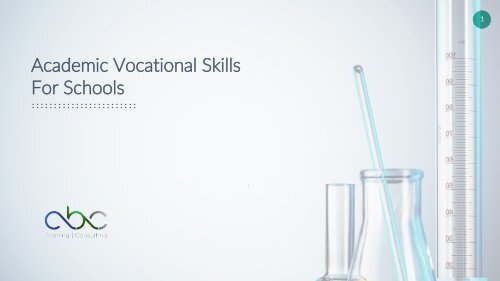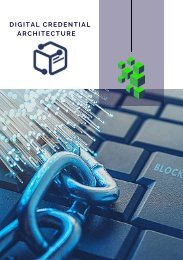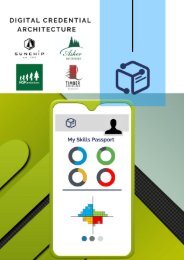ABC LabSkills VETiS Emerald
You also want an ePaper? Increase the reach of your titles
YUMPU automatically turns print PDFs into web optimized ePapers that Google loves.
1<br />
Academic Vocational Skills<br />
For Schools<br />
.
VET but not as you know it.<br />
2<br />
Accreditation is<br />
Broad application<br />
not about learning<br />
of units<br />
The whole vocational system is<br />
designed around not what you<br />
have learned but what you can do !<br />
VET does not have<br />
to be prescriptive<br />
Specifically for MSL<br />
qualifications, the U.O.Cs are<br />
very broad in their application.<br />
Packaging and electives<br />
are your friends<br />
Most programs are developed<br />
for compliance purposes.<br />
Don’t be defined by the RTO.<br />
Choose what is best for the<br />
Packages and qualifications are<br />
developed typically in a<br />
structural hierarchy via<br />
Ironically, it is the inverse of how<br />
qualifications are developed.<br />
outcomes.<br />
NB. MSL952002 Handle and transport<br />
samples or equipment<br />
Development of a occupation<br />
profile and Functional Analysis.<br />
These are never done in<br />
isolation and hence 98% of<br />
Special note to Specialisations<br />
qualifications have electives.<br />
Used correctly you can save<br />
time and get better outcomes<br />
and significant efficiencies
VET but not as you know it.<br />
3<br />
Unlimited foci
Delivery does not have to be standard<br />
4<br />
It is simply economics and mechanics<br />
Intensive Models<br />
Timetabled Models<br />
Integrated Models<br />
Project based<br />
integrated curriculum<br />
2 -3 week block sessions<br />
which are project based<br />
to cover practicals<br />
supplemented with<br />
online learning to cover<br />
Knowledge<br />
Programs are timetabled<br />
at regular intervals<br />
typically as elective<br />
lessons<br />
Where programs are<br />
integrated into another<br />
subject and taught as a<br />
part of that curriculum.<br />
e.g. chemistry, biology,<br />
science in practice<br />
Our programs can form a<br />
part of and integrated<br />
curriculum package<br />
including<br />
• Mathematics<br />
• A science<br />
.<br />
• English<br />
• Geography
Our Industry<br />
5<br />
Partnerships<br />
This is our 5 th Year working with SeaWorld<br />
<strong>ABC</strong> has been working with SeaWorld on these<br />
programs for four years and have developed bespoke<br />
processes for Lab Courses<br />
Partnership with local industry<br />
We even have partnerships with breweries,<br />
distilleries, construction, mining, health and even the<br />
military. We can work with any major local industry<br />
Partnerships with Universities<br />
We have 3 Partnerships and are working on another<br />
7 with universities where we have complementary<br />
programs. E.g. Torrens for Nursing and natural<br />
medicine, JCU for Environmental, Griffith for Medical<br />
Science.<br />
Embedded University Microcredentials<br />
In 2023 we will have the opportunity to add<br />
university micro-credentials into our program
Example of Intensive Model<br />
Timeline<br />
6<br />
E-learning Conducted 1 hour per week<br />
Can include SeaWorld Excursion<br />
Students enroll online Term 1<br />
Intensive Practical<br />
Either 6 days, 2 x 1 week, 8 x<br />
1 Day<br />
Certificate Issued and Registered
Vocational Programs for Academic Students<br />
7<br />
20%<br />
30%<br />
20%<br />
30%<br />
Pure Academic<br />
STEM skills-based programs with Microcredentials<br />
articulations and credit at Uni<br />
Academic Pathway<br />
Academic pathways with direct entry with<br />
ATAR Backups.<br />
ATAR/Vocational Options<br />
ATAR Eligible but would benefit from<br />
Backup ATAR Alternatives<br />
Vocational/Work Pathway<br />
Further Vocational pathways or Direct<br />
Employment<br />
Our programs are tailored for<br />
any student cohort but is<br />
typically aimed at students on<br />
an ATAR pathway allowing<br />
non-ATAR students to use<br />
their <strong>VETiS</strong> funding for<br />
vocational pursuits.
Flexible Options to Provide Maximal Student Outcomes<br />
8<br />
99%<br />
1:20<br />
1:8<br />
5<br />
6 68<br />
QCE Points<br />
ATAR Score<br />
equivalent<br />
Completion<br />
Rates<br />
99.8% over 4000<br />
Students<br />
Free student<br />
Ratios<br />
For Larger cohorts we<br />
can do 1 student free<br />
for every 8 funded<br />
students ) for students<br />
ineligible or who have<br />
used their funding)<br />
Trainer to<br />
Student Ratios<br />
5 different<br />
delivery<br />
Models<br />
The programs can be<br />
delivered 5 different<br />
ways .
What Does an Integrated<br />
9<br />
Model Look Like<br />
MSL30118 and QCAA Senior Biology<br />
Mandatory practical: Investigate the effect of surface area<br />
to volume ratio on cell size.<br />
Mandatory practical: Prepare wet mount slides and use a light microscope to observe<br />
cells in microorganisms, plants and animals to identify nucleus, cytoplasm, cell wall,<br />
chloroplasts and cell membrane.<br />
MSL913004 – Plan and conduct laboratory/field work.<br />
Mandatory practical: Investigate the effect of an antimicrobial on<br />
the growth of a microbiological organism (via the measurement of<br />
zones of inhibition) — laboratory or virtual.<br />
MSL973016 – Perform aseptic techniques<br />
Mandatory practical: Investigate the effect of temperature on the rate<br />
of reaction of an enzyme.<br />
MSL973020 – Perform Histological Procedures<br />
Mandatory practical: Investigate the effect of temperature on the<br />
rate of reaction of an enzyme.<br />
MSL973013 - Perform basic tests<br />
Mandatory practical: Compare the distribution of stomata and guard cells<br />
in plants adapted to different environments (aquatic, terrestrial)<br />
as an adaptation for osmoregulation in plant tissue.<br />
MSL973019 – Perform microscopic examination<br />
Mandatory practical: Prepare wet mount slides and use a light<br />
microscope to observe cells in microorganisms, plants and animals<br />
to identify nucleus, cytoplasm, cell wall, chloroplasts and cell<br />
membrane. The student is required to calculate total magnification<br />
and field of view.<br />
MSL973019 – Perform microscopic examination
What Does a Project-based<br />
10<br />
Integrated Curriculum Look Like<br />
Example: Environmental Science<br />
Science in practice, Earth & Environmental Science<br />
or Marine Science<br />
Geography<br />
Planning sustainable places<br />
Base for Tests • MSL973013 Perform basic tests<br />
• MSL943004 Participate in laboratory or field workplace safety<br />
• MSMENV272 Participate in environmentally sustainable work<br />
practices<br />
English or essential English<br />
Report Writing – Language that works, Textual connections<br />
• MSL922001 Record and present data<br />
• MSL913003 Communicate with other people<br />
Essential Mathematics or Mathematical Methods<br />
Statistics and Data<br />
• MSL922001 Record and present data<br />
• MSL972001 Conduct routine site measurements<br />
• MSL952001 Collect routine site samples<br />
Marine Science and Aquatic Practices<br />
Marine systems — connections and<br />
change<br />
MSL913004 Plan and conduct laboratory/field work
Things to Consider<br />
11<br />
We can provide F.O.C students<br />
Not advantageous<br />
to do it yourself<br />
Pre-defined pathways<br />
Any Variety of Models<br />
While largely based on scale<br />
We get paid 300% more to do it.<br />
• Universities<br />
• Excellence programs<br />
we can generally provide 1:6-<br />
1:8 F.O.C. students so that<br />
they can use their <strong>VETiS</strong><br />
Funding for other programs<br />
• No compliance<br />
• No downtime<br />
• No Vocational Competence<br />
• Everything provided<br />
• Further studies<br />
• Jobs<br />
• Whole cohort programs<br />
• Permanent Staff available<br />
• Industrial Chemists,<br />
Medical Scientists,<br />
Phlebotomists,<br />
Pathologists on staff.
12<br />
Badges, Micro-Credentials<br />
and Open Skills<br />
.
Why did they come about?<br />
13<br />
Degree Inflation<br />
Specifically in Western economies,<br />
this higher-level demand has led to<br />
significant skills shortages in<br />
demonstrable technical skills,<br />
resulting in inflation of the value in<br />
these areas.<br />
The Credentialing Club<br />
The dependence on degrees as the primary<br />
means by which we collectively judge what<br />
someone knows and can do has posed<br />
significant risk to organisations who use this<br />
as evidence of competence.<br />
Rapid Shift<br />
it appears that we’re experiencing a shift away from<br />
the gold standard of degrees and toward a more<br />
inclusive credentialing world that embraces microcredentials<br />
and is based on a market-driven floating<br />
exchange rate.
What is happening Globally?<br />
14<br />
• there are significant movements from traditional institution-based<br />
credentials towards a more dynamic, person-centric approach<br />
whereby an individual develops, records and presents their<br />
achievements independently from the issuing institutions.<br />
3 primary developments<br />
• Capability of immutability and validation of certifications outside of<br />
the issuing institutions via Blockchain<br />
• The movement towards the collection and accreditation of skills and<br />
capabilities evidence through the collection and presentation of<br />
verifiable micro-credentials.<br />
• The dynamic nature of future skills requirements that are<br />
incommensurate with traditional education models<br />
• The Comprehensive Learner Record (CLR) is a technical<br />
specification that is designed to support traditional<br />
education programs<br />
• CLR is designed to be used, curated, and controlled by<br />
the learner
Open Ecosystem<br />
15
What are Micro-credentials?<br />
16<br />
• A certification of assessed skills and knowledge that<br />
learners have demonstrated or acquired through a<br />
short course of study or training.<br />
• Indicate competency of a skill found in a particular<br />
industry area.<br />
• May stand alone or be additional, or complementary,<br />
to other certificated training. They may also be a<br />
component part of a formal qualification.<br />
National Framework Definition<br />
3.1.1 A micro-credential is a certification of assessed learning or<br />
competency, with a minimum volume of learning of one hour and<br />
less than an AQF award qualification, that is additional, alternate,<br />
complementary to or a component part of an AQF award<br />
qualification.<br />
<br />
<br />
<br />
<br />
VET skill sets or units of competency.<br />
Modularized, assessed components of existing higher<br />
education curriculum or subjects.<br />
Industry learning that is assessed (such as vendor<br />
certifications, professional learning).<br />
Other forms of assessed learning or competencies (e.g.<br />
Vocational Education/ Higher Education /Industry courses not<br />
currently accredited by a regulatory authority, and those by<br />
other providers).<br />
.
What’s Happening in <strong>VETiS</strong> Nationally<br />
17<br />
3 Key Reports<br />
(The Joyce Review 2019, The Firth Review 2020, Shergold Review 2020)<br />
• Harmonisation of <strong>VETiS</strong> Programs Nationally<br />
• Creating pathways through the traditional curriculum<br />
• Critical of QCAA Delegation of ASQA for Schools<br />
• Promotion of VET to non-vet students<br />
• all students have access to a high-quality vocational pathway that<br />
includes <strong>VETiS</strong> options with the most appropriate provider. (NSW/VIC)<br />
• Strengthened Collaborations between industry and schools (n.b. CSIRO)<br />
by 2023, all secondary students must be enrolled in a VET<br />
By 2025, the VET sector should be a highly regarded pathway for students seeking<br />
qualification in Victoria!<br />
applied training for a range of careers, and for employees seeking to upskill or transition<br />
to new occupations.<br />
• Credentials for the partial completion of identified subjects in some<br />
qualifications.<br />
• Students should leave school with a Learner Profile that incorporates not<br />
only their ATAR score (where relevant) but also captures the broader range<br />
of evidenced capabilities<br />
• encouraging the use of short-form credentials such as skillsets or microcredentials<br />
to provide more flexible training options to industry,<br />
• design a Digital Education Passport for lifelong learning
How Skills Data is Reshaping Workforce Development<br />
18
National Framework Vs International<br />
19<br />
National Framework<br />
Title<br />
Provider<br />
Content<br />
Outcomes<br />
Delivery Mode<br />
Date of Delivery<br />
VOL<br />
resources<br />
price<br />
assessment<br />
Certification<br />
Credit<br />
QA<br />
Prerequisits<br />
Expiration<br />
Jurisdiction<br />
Stacking<br />
Industry Alignment<br />
OSN and Blocksure<br />
Title<br />
Provider<br />
RSD Owner<br />
Description<br />
Outcomes<br />
Skills<br />
Skill Clusters<br />
General Catagories<br />
UOCs<br />
Digital Specific Skills<br />
Delivery Type as per avetmiss<br />
Date of Delivery<br />
Earning criteria<br />
Can be added but inherited in VET<br />
Price<br />
Earning criteria<br />
Conditional Assessment<br />
Blockchain secured<br />
5 x additional criteria<br />
inherited in VET and Pathways<br />
Only QA assured issuances<br />
inherited in VET and Pathways<br />
Expiration<br />
Inherited Via Credentials<br />
Unrestricted Pathways<br />
Industry<br />
Standards<br />
Articulations<br />
individual Company<br />
Unlimited articulations<br />
Occupational Profiles<br />
Skills Profiles<br />
Live Job links
Open Badges
Claim Your Badge<br />
22
There is more than just issuance.<br />
23
O p e n B a d g e Pa th w a y s<br />
A learning pathway is the chosen route individuals complete as they progress through a range of specific courses, academic programs, and learning experiences. It is a roadmap describing the landscape of a field, program or specialization.<br />
Pathways are made of steps that represent requirements, competencies, or other "real-world" experiences and take the form of a hierarchy of nested steps. Equating this to the Australian context it can be equated to an evidentiary and<br />
defined recognition of prior learning process utilising the attributes of digital credentials and badging.
Pathways with Multiple Vendors
Skills Pathways and progression extensions<br />
Live Jobs Board<br />
with API to indeed, linkedin or seek,<br />
a live jobs board could be<br />
developed for that occupation<br />
Job 1<br />
Position Name<br />
apply<br />
Job 1<br />
Position Name<br />
Job 1<br />
Position Name<br />
Live Jobs
Blocksure App<br />
28<br />
Store Share Credentials Share Badges Share physically Verify
6 functions 1 APP<br />
29
Review<br />
• MSL20118 and MSl30118 are Highly versatile and customizable<br />
30<br />
• They can be incorporated into traditional curriculum<br />
• There are many models we can develop<br />
• Schools are in control<br />
• SeaWorld Programs can be integrated<br />
• VET has had a bad name but that is changing<br />
• Huge focus on Vocational pathways coming<br />
• National changes to <strong>VETiS</strong> coming<br />
• QCAA as ASQA regulator unlikely to continue<br />
• Diplomas in schools under the microscope<br />
• Co-provider agreements are on the out.<br />
• Digital Skills are going to be a focus<br />
• Microcredentials are here and will be the standard<br />
• You can work under our platform<br />
• <strong>ABC</strong> has an app coming (Jan) that will be able to store and share both<br />
Credentials and Badges.<br />
• We are here to help if you have any questions
Any questions ?<br />
31
32<br />
Thankyou for<br />
your time





